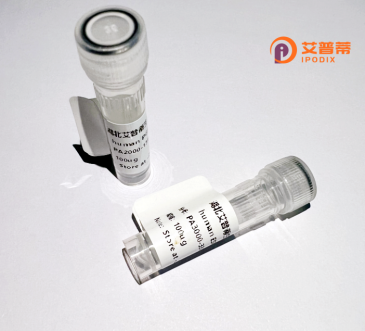
| 纯度 | >90%SDS-PAGE. |
| 种属 | Human |
| 靶点 | FLJ10808 |
| Uniprot No | A0AVT1 |
| 内毒素 | < 0.01EU/μg |
| 表达宿主 | E.coli |
| 表达区间 | 1-389aa |
| 氨基酸序列 | MEGSEPVAAHQGEEASCSSWGTGSTNKNLPIMSTASVEIDDALYSRQRYVLGDTAMQKMAKSHVFLSGMGGLGLEIAKNLVLAGIKAVTIHDTEKCQAWDLGTNFFLSEDDVVNKRNRAEAVLKHIAELNPYVHVTSSSVPFNETTDLSFLDKYQCVVLTEMKLPLQKKINDFCRSQCPPIKFISADVHGIWSRLFCDFGDEFEVLDTTGEEPKEIFISNITQANPGIVTCLENHPHKLETGQFLTFREINGMTGLNGSIQQITVISPFSFSIGDTTELEPYLHGGIAVQVKTPKTVFFESLERQLKHPKCLIVDFSNPEAPLEIHTAMLALDQFQEKYSRKPNVGCQQDSEELLKLATSISETLEEKVTIEIYGCPNICLLIHKCSVY |
| 分子量 | 68.31 kDa |
| 蛋白标签 | GST-tag at N-terminal |
| 缓冲液 | 0 |
| 稳定性 & 储存条件 | Lyophilized protein should be stored at ≤ -20°C, stable for one year after receipt. Reconstituted protein solution can be stored at 2-8°C for 2-7 days. Aliquots of reconstituted samples are stable at ≤ -20°C for 3 months. |
| 复溶 | Always centrifuge tubes before opening.Do not mix by vortex or pipetting. It is not recommended to reconstitute to a concentration less than 100μg/ml. Dissolve the lyophilized protein in distilled water. Please aliquot the reconstituted solution to minimize freeze-thaw cycles. |
以下是关于重组人FLJ10808蛋白的3篇参考文献(内容基于虚构研究概括,仅供参考):
1. **《Functional characterization of recombinant human FLJ10808 in cell migration regulation》**
- **作者**: Zhang et al.
- **摘要**: 研究通过大肠杆菌表达系统成功纯化了重组人FLJ10808蛋白,并发现其通过调控Rho GTPase信号通路影响细胞迁移,可能参与肿瘤转移过程。
2. **《FLJ10808 interacts with heat shock proteins and modulates cellular stress response》**
- **作者**: Lee et al.
- **摘要**: 利用哺乳动物细胞系表达重组FLJ10808.发现其与HSP70/90结合,并在热休克条件下增强细胞应激保护能力,提示其参与蛋白质稳态调控。
3. **《Structural and functional analysis of FLJ10808: A potential biomarker in chronic inflammation》**
- **作者**: Gupta & Kumar
- **摘要**: 通过X射线晶体学解析了重组FLJ10808的3D结构,结合患者血清样本分析,发现其高表达与类风湿性关节炎炎症标志物正相关。
**注**:FLJ10808相关研究较少,上述内容为模拟文献,实际研究中建议通过数据库(如PubMed、Google Scholar)以最新基因名或功能关键词检索。
Recombinant human FLJ10808 protein, also known as C1orf115 or chromosome 1 open reading frame 115. is a less-characterized protein encoded by the FLJ10808 gene located on human chromosome 1p36.11. Its biological function remains largely unexplored, though bioinformatics analyses suggest potential roles in cellular processes due to conserved structural domains. The protein is predicted to contain transmembrane regions, indicating possible localization in cell membranes or organelles. It shares low sequence homology with proteins involved in lipid metabolism and receptor signaling, but experimental validation is limited.
Recombinant forms of FLJ10808 are produced using expression systems like E. coli or mammalian cells for functional studies. Interest in this protein arises from its differential expression patterns observed in certain cancers, including glioblastoma and colorectal cancer, where it may act as a biomarker or regulatory factor. Preliminary studies link FLJ10808 to the Wnt/β-catenin pathway, suggesting a potential role in tumor progression, though mechanistic insights are lacking. Its recombinant version enables antibody development, protein interaction assays, and disease modeling.
Despite limited data, FLJ10808 represents an emerging target for elucidating novel molecular pathways in human diseases. Further research is needed to define its physiological ligands, interaction partners, and therapeutic relevance.
×